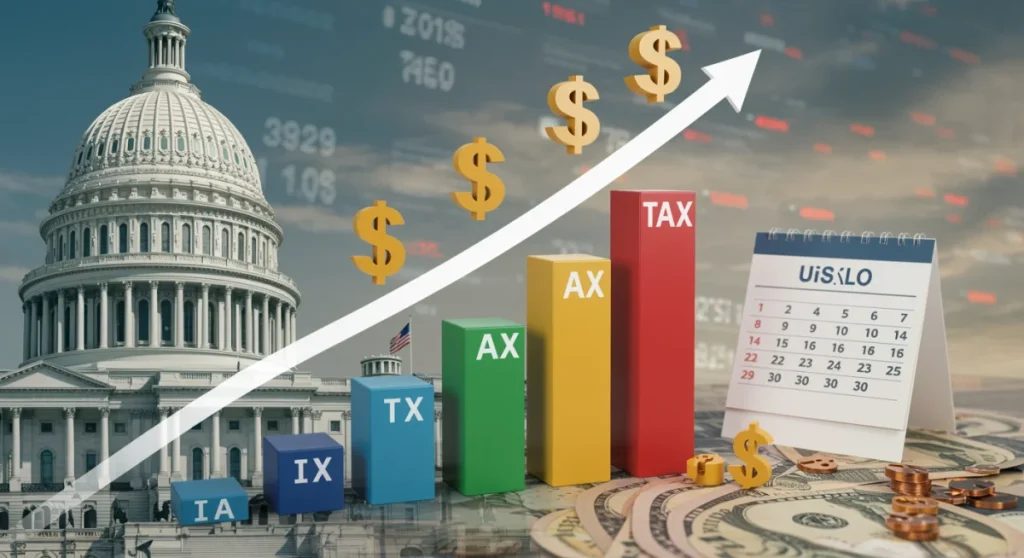2025 IRS Tax Brackets: Navigating for Optimal Savings

Anúncios
Understanding the upcoming adjustments to the 2025 IRS tax brackets is crucial for every American to effectively plan their finances, identify potential savings opportunities, and ensure compliance with new federal tax regulations.
Anúncios
As the calendar pages turn towards 2025, a significant financial shift looms for every American taxpayer: the adjustments to the 2025 IRS tax brackets. These changes are not merely numbers on a form; they represent a fundamental recalibration of how much of your hard-earned income goes to federal taxes, directly impacting your financial health and future planning. Proactive understanding and strategic adaptation are key to navigating these updates effectively and identifying optimal savings opportunities.
Understanding the Basics of Tax Brackets
Before delving into the specifics of the 2025 changes, it’s essential to grasp the foundational concept of how tax brackets work. The U.S. federal income tax system operates on a progressive scale, meaning different portions of your income are taxed at different rates. This isn’t a flat tax; instead, your income falls into various brackets, each with its own marginal tax rate.
Anúncios
For instance, if you earn $50,000, not all of it is taxed at the highest rate your income reaches. The first segment is taxed at the lowest rate, the next segment at a slightly higher rate, and so on, until your entire taxable income is accounted for. This progressive structure is designed to ensure that those with higher incomes contribute a larger percentage of their earnings to federal taxes. Understanding this tiered system is the first step in comprehending how any adjustments to the brackets will affect your personal finances.
How Marginal Tax Rates Apply
Many taxpayers mistakenly believe that if their income pushes them into a higher tax bracket, their entire income will be taxed at that higher rate. This is a common misconception. Instead, only the portion of income that falls within a particular bracket is subject to this bracket’s marginal rate. This distinction is crucial for financial planning.
- Progressive System: Income is divided into segments, each taxed at a specific rate.
- Marginal Rate: The tax rate applied to the last dollar of income earned.
- Effective Tax Rate: The total tax paid divided by total taxable income, which is always lower than your highest marginal rate.
The implications of this system are profound. It means that earning an extra dollar that pushes you into a new bracket will not suddenly make you pay more tax overall. You’ll only pay the higher rate on that specific extra dollar and any subsequent income within that new bracket, not on your entire income. This nuance is vital for making informed decisions about raises, bonuses, and investment income.
In essence, tax brackets define the segments of taxable income and their corresponding tax rates. As we prepare for 2025, these thresholds and rates are subject to inflation adjustments and potential legislative changes, making it imperative to stay informed about the new figures. A solid grasp of these fundamentals provides the necessary groundwork for understanding the upcoming shifts and planning accordingly.
Key Changes Expected in 2025 Tax Brackets
The year 2025 is anticipated to bring notable changes to the IRS tax brackets, primarily driven by inflation adjustments. These adjustments are a regular occurrence, designed to prevent “bracket creep,” where inflation pushes taxpayers into higher tax brackets even if their purchasing power hasn’t increased. While the specific percentages for 2025 are finalized closer to the end of 2024, the general direction and impact can be projected based on current economic trends and historical patterns.
These changes will affect various filing statuses, including single filers, married filing jointly, married filing separately, and head of household. Each status has its own set of income thresholds for each tax bracket. The primary goal of these adjustments is to maintain the relative tax burden across different income levels in the face of economic fluctuations. However, even minor shifts can have a significant cumulative impact on individual tax liabilities and financial strategies.
Inflation Adjustments and Their Impact
The IRS typically adjusts tax parameters annually to account for inflation, using the Consumer Price Index (CPI) as a primary metric. For 2025, these adjustments are expected to raise the income thresholds for each tax bracket, meaning taxpayers might be able to earn slightly more before moving into a higher bracket. This is generally a positive development for taxpayers, as it can result in a lower effective tax rate for the same real income.
- Higher Income Thresholds: More income can fall into lower tax brackets.
- Reduced Bracket Creep: Helps prevent taxpayers from being penalized by inflation.
- Impact on Deductions: Standard deductions and other tax parameters are also adjusted.
Beyond the brackets themselves, other critical tax provisions are also subject to inflation adjustments. These include the standard deduction, various tax credits, and contribution limits for retirement accounts like 401(k)s and IRAs. Keeping track of these interconnected changes is crucial for a holistic tax planning approach, as they collectively determine your overall tax liability and opportunities for savings.
While the exact figures are not yet public, staying informed through reliable sources like the IRS website and reputable financial news outlets is paramount. These anticipated adjustments underscore the dynamic nature of the U.S. tax code and the continuous need for taxpayers to review and adapt their financial strategies to optimize their tax position for the upcoming year.
Strategies for Optimal Savings Under New Brackets
Navigating the adjusted 2025 tax brackets effectively requires a proactive and informed approach. Beyond simply understanding the new numbers, taxpayers can implement various strategies to optimize their savings and minimize their tax liability. These strategies often involve leveraging deductions, credits, and tax-advantaged investment vehicles.
One of the most immediate actions is to review your current withholding. If your income or deductions have changed, or if you anticipate significant shifts due to the new brackets, adjusting your W-4 form with your employer can prevent overpaying or underpaying taxes throughout the year. This ensures that your tax payments are aligned with your actual liability, avoiding large refunds (which means you lent the government money interest-free) or unexpected tax bills.
Maximizing Deductions and Credits
Deductions and credits are powerful tools for reducing your taxable income or directly lowering your tax bill. With the 2025 adjustments, it’s vital to reassess which deductions and credits you qualify for and how to maximize them.
- Standard vs. Itemized Deductions: Determine which option provides the greater tax benefit based on your expenses.
- Tax Credits: Explore eligibility for credits like the Child Tax Credit, Earned Income Tax Credit, or education credits, which directly reduce your tax liability.
- Above-the-Line Deductions: Contributions to traditional IRAs, student loan interest, and health savings account (HSA) contributions can reduce your adjusted gross income (AGI), potentially impacting eligibility for other credits and deductions.
For those who itemize, tracking eligible expenses throughout the year is crucial. This includes mortgage interest, state and local taxes (SALT cap permitting), medical expenses exceeding a certain AGI threshold, and charitable contributions. Even if you don’t itemize, understanding above-the-line deductions can significantly impact your tax outcome.
Another key strategy involves tax-advantaged retirement accounts. Contributions to 401(k)s, IRAs, and HSAs not only help you save for the future but also offer immediate tax benefits. Traditional contributions are often tax-deductible, reducing your current taxable income, while Roth contributions offer tax-free withdrawals in retirement. The choice between traditional and Roth depends on your current and projected future income and tax bracket. Consulting with a financial advisor can help tailor these strategies to your unique financial situation and maximize your savings under the new tax framework.
Impact on Retirement and Investment Planning
The adjustments to the 2025 tax brackets will inevitably influence retirement and investment planning strategies. Understanding these implications is crucial for making informed decisions that optimize long-term financial growth and minimize tax burdens during accumulation and withdrawal phases. The interplay between your income, tax rates, and investment choices can significantly alter your financial trajectory.
For instance, changes in marginal tax rates might alter the appeal of traditional versus Roth retirement accounts. If you anticipate being in a higher tax bracket now than in retirement, traditional contributions (which are tax-deductible in the present) might be more advantageous. Conversely, if you expect to be in a higher tax bracket during retirement, Roth contributions (which are tax-free upon withdrawal) could be more beneficial. These decisions are highly personalized and require careful consideration of future income projections.

Tax-Advantaged Accounts and Rebalancing
The new brackets necessitate a review of your utilization of various tax-advantaged accounts. Contribution limits for 401(k)s, IRAs, and Health Savings Accounts (HSAs) are also typically adjusted for inflation, offering opportunities to shield more income from current taxes.
- 401(k) and IRA Contributions: Maximize contributions to reduce taxable income and benefit from tax-deferred growth.
- Health Savings Accounts (HSAs): Triple tax advantage (tax-deductible contributions, tax-free growth, tax-free withdrawals for qualified medical expenses) makes HSAs a powerful tool.
- Capital Gains Considerations: Changes in tax brackets can affect the tax rates on long-term capital gains and qualified dividends.
Beyond contributions, consider rebalancing your investment portfolio in light of potential changes to capital gains tax rates. For example, if you anticipate selling appreciated assets, understanding the long-term capital gains rates for your income bracket is vital. These rates are distinct from ordinary income tax rates and can significantly impact the after-tax returns on your investments. Strategic tax-loss harvesting, where you sell investments at a loss to offset capital gains and a limited amount of ordinary income, remains a valuable tactic.
Ultimately, the 2025 tax bracket adjustments serve as a timely reminder to review your entire financial plan. This includes not just your immediate tax liability but also your long-term retirement savings, investment strategies, and estate planning. Engaging with a qualified financial advisor can provide tailored insights and help you navigate these changes to secure your financial future.
Common Pitfalls and How to Avoid Them
Even with a clear understanding of the 2025 IRS tax brackets, taxpayers can fall into common pitfalls that lead to missed savings opportunities or unexpected tax liabilities. Being aware of these traps and knowing how to avoid them is just as important as understanding the new tax code itself. Proactive measures and careful attention to detail can make a significant difference in your annual tax outcome.
One frequent mistake is failing to adjust withholding throughout the year. Life events such as marriage, divorce, birth of a child, a new job, or significant income changes can all impact your tax situation. If your W-4 isn’t updated, you might end up paying too much tax, essentially giving the government an interest-free loan, or worse, not paying enough and incurring penalties at tax time. Regularly reviewing your financial situation against your withholding is a simple yet effective preventative measure.
Overlooking Minor Changes and Misinterpreting Information
The details in tax law are often where significant savings or costly errors reside. Overlooking seemingly minor adjustments or misinterpreting tax information can have substantial consequences.
- Ignoring Inflationary Adjustments: Not accounting for changes in standard deductions, credit phase-outs, or retirement contribution limits.
- Relying on Outdated Information: Tax laws evolve; ensure your sources are current and reputable.
- Failing to Keep Accurate Records: Messy records can lead to missed deductions or an inability to substantiate claims if audited.
Another common pitfall is misunderstanding the difference between tax deductions and tax credits. A deduction reduces your taxable income, while a credit directly reduces the amount of tax you owe, dollar for dollar. Credits are generally more valuable than deductions. Forgetting to claim eligible credits or miscalculating them can leave money on the table that rightfully belongs in your pocket. Furthermore, many credits have income limitations, so it’s essential to understand phase-out rules.
Finally, attempting to navigate complex tax situations without professional advice can be a costly mistake. While tax software can handle many straightforward returns, unique circumstances, such as self-employment income, large investment gains, or significant life changes, often warrant the expertise of a qualified tax professional. Their guidance can help you avoid errors, identify all eligible deductions and credits, and ensure compliance with the ever-changing tax landscape, ultimately saving you time and money.
Preparing Your Finances for 2025
Effective financial preparation for the 2025 tax brackets involves more than just understanding the numbers; it requires a holistic approach to your entire financial picture. This means reviewing your budget, savings, investments, and even your long-term financial goals in light of the upcoming tax changes. Proactive planning allows you to not only adapt but also to strategically position yourself for maximum benefit.
Start by gathering all relevant financial documents from the current and previous years. This includes pay stubs, investment statements, records of deductible expenses, and previous tax returns. Having these documents organized will provide a clear snapshot of your historical financial activity and help you project for the upcoming year. This foundational step is critical for accurate forecasting and informed decision-making.
Actionable Steps for Proactive Planning
Once you have a clear understanding of your financial landscape, several actionable steps can be taken to prepare for 2025.
- Review and Adjust Withholding: Use the IRS Tax Withholding Estimator to ensure your W-4 accurately reflects your expected income and deductions for 2025.
- Maximize Retirement Contributions: Aim to contribute the maximum allowable to your 401(k), IRA, and HSA, especially if contribution limits increase.
- Plan for Significant Life Events: Anticipate major changes like marriage, childbirth, home purchase, or career shifts, and understand their tax implications.
Consider conducting a year-end tax review before 2024 concludes. This allows you to make any necessary adjustments to your income or expenses that could impact your 2024 tax return, potentially setting you up for a better position in 2025. For example, accelerating or deferring income or deductions can sometimes yield tax advantages, depending on your current and projected tax bracket.
Finally, make it a habit to stay informed about tax law changes. The IRS website, reputable financial news sources, and professional tax publications are excellent resources. Tax laws are dynamic, and continuous learning is essential for maintaining an optimized financial strategy. By taking these proactive steps, you can confidently navigate the 2025 tax landscape and ensure your finances are well-prepared for the future.
Seeking Professional Guidance for Tax Planning
While understanding the 2025 IRS tax brackets and implementing general savings strategies is beneficial, complex financial situations often warrant the expertise of a qualified tax professional. The U.S. tax code is intricate and constantly evolving, making it challenging for individuals to keep up with every nuance and ensure optimal compliance and savings. A professional can offer personalized advice tailored to your specific circumstances, helping you uncover opportunities you might otherwise miss.
Tax professionals, such as Certified Public Accountants (CPAs), Enrolled Agents (EAs), or financial advisors specializing in tax, possess deep knowledge of tax law, deductions, credits, and investment strategies. They can analyze your income, expenses, assets, and liabilities to develop a comprehensive tax plan that aligns with your financial goals. Their insights can be particularly valuable if you have multiple income streams, own a business, have significant investments, or have experienced major life changes.
When to Consult a Tax Professional
Deciding when to seek professional tax guidance can be a critical step in optimizing your financial health. Several scenarios particularly benefit from expert intervention.
- Complex Financial Situations: Self-employment, rental properties, significant investment portfolios, or foreign income.
- Major Life Events: Marriage, divorce, inheritance, starting a family, or purchasing a home.
- Desire for Strategic Planning: Long-term wealth building, estate planning, or minimizing future tax liabilities.
- Uncertainty or Compliance Concerns: If you’re unsure about specific tax rules or worried about audit risk.
A good tax professional does more than just prepare your tax return; they serve as a strategic partner. They can help you project your tax liability for the upcoming year, advise on tax-efficient investment strategies, guide you through charitable giving options, and even represent you in the event of an IRS audit. Their expertise can not only save you money but also provide peace of mind, knowing that your tax affairs are handled correctly and efficiently.
Before selecting a professional, ensure they are reputable, have relevant experience, and are transparent about their fees. Ask for referrals, check credentials, and schedule an initial consultation to discuss your needs. Investing in professional tax guidance can yield significant returns, ensuring you are fully prepared for the 2025 tax brackets and beyond, maximizing your savings, and confidently navigating the complexities of the tax system.
| Key Aspect | Brief Description |
|---|---|
| Bracket Adjustments | Inflation-driven changes to income thresholds for each tax rate, preventing bracket creep. |
| Savings Strategies | Maximizing deductions, credits, and contributions to tax-advantaged accounts. |
| Retirement Impact | Influences choices between Traditional and Roth accounts, and capital gains planning. |
| Professional Guidance | Seeking expert advice for complex situations ensures compliance and optimized outcomes. |
Frequently Asked Questions About 2025 Tax Brackets
The primary driver for changes in the 2025 tax brackets is inflation. The IRS annually adjusts income thresholds and other tax parameters based on the Consumer Price Index (CPI) to prevent “bracket creep,” ensuring taxpayers are not pushed into higher brackets simply due to inflation without an increase in real income.
The impact on your take-home pay depends on your income level and filing status. Generally, if income thresholds increase, you might be able to earn more before moving into a higher tax bracket, potentially leading to a slightly lower overall tax burden and thus more take-home pay. Adjusting your W-4 is crucial.
Yes, standard deductions are typically adjusted annually for inflation, similar to tax brackets. These adjustments can impact whether it’s more advantageous for you to take the standard deduction or itemize your deductions, which can significantly affect your overall taxable income.
A tax deduction reduces your taxable income, lowering the amount of income subject to tax. A tax credit, on the other hand, directly reduces the amount of tax you owe, dollar for dollar. Tax credits are generally more valuable as they provide a direct reduction of your tax liability.
For complex financial situations, significant life changes, or a desire for strategic long-term planning, consulting a qualified tax professional is highly recommended. They can provide personalized advice, identify all eligible savings opportunities, and ensure compliance with the evolving tax code.
Conclusion
The upcoming adjustments to the 2025 IRS tax brackets represent a crucial financial waypoint for every American. By understanding the basics of how tax brackets function, staying informed about the inflation-driven changes, and implementing proactive strategies, taxpayers can effectively navigate this evolving landscape. Maximizing deductions and credits, optimizing retirement and investment planning, and avoiding common pitfalls are all essential components of a sound financial strategy. For those with complex financial situations, seeking professional guidance can provide invaluable insights and ensure compliance, ultimately leading to optimal savings and a more secure financial future. Preparing now is not just about avoiding penalties; it’s about seizing opportunities to strengthen your financial well-being.





